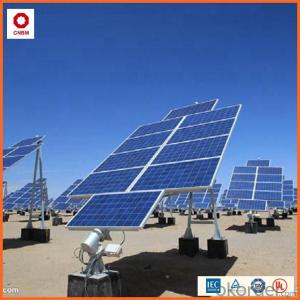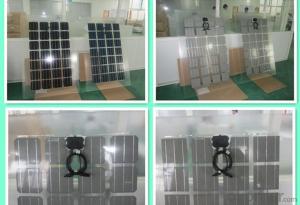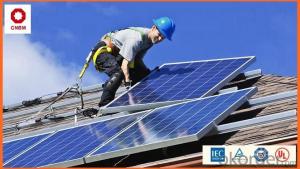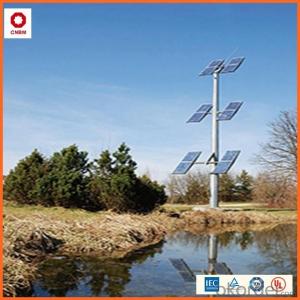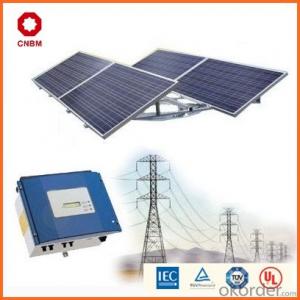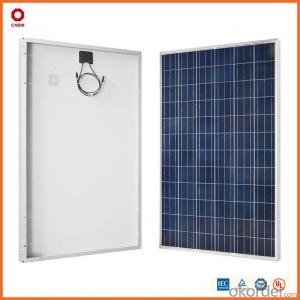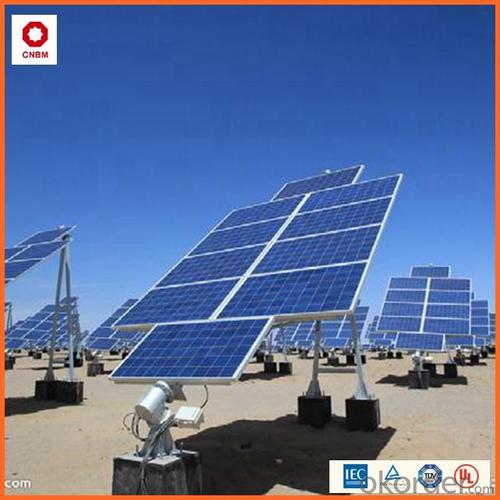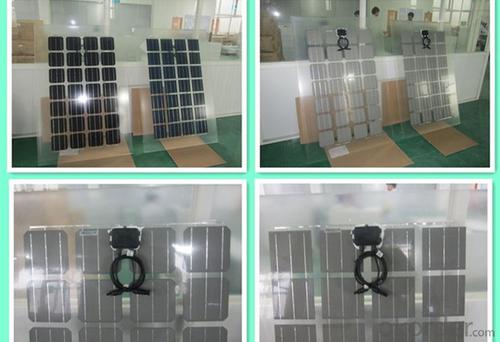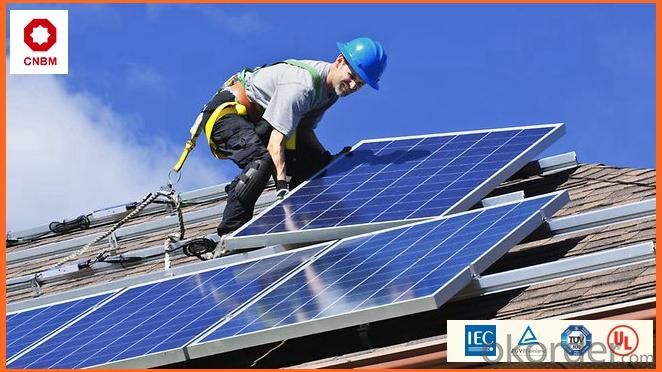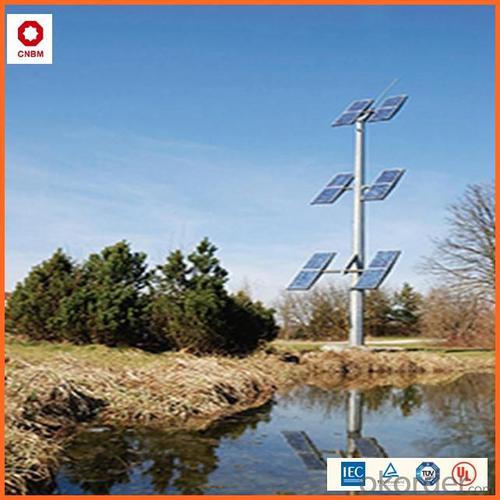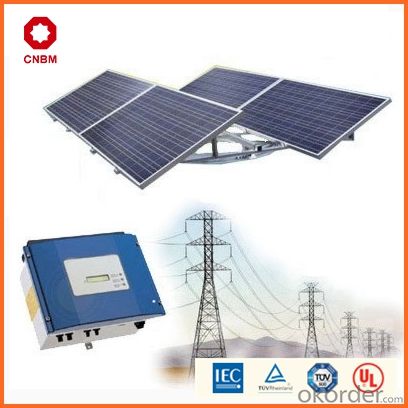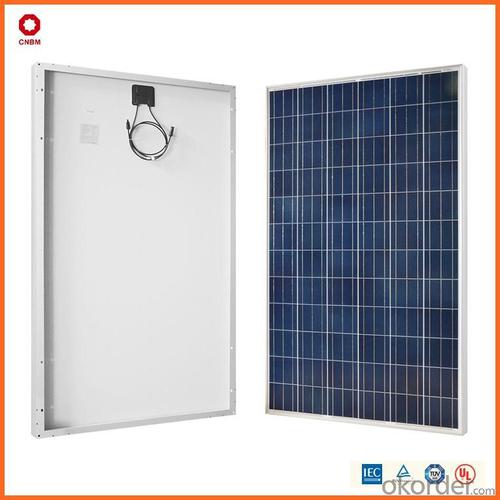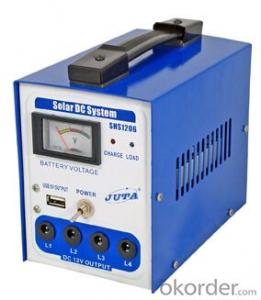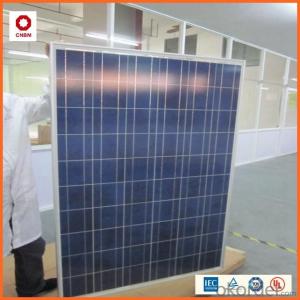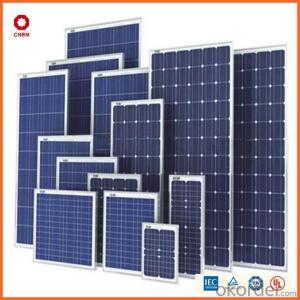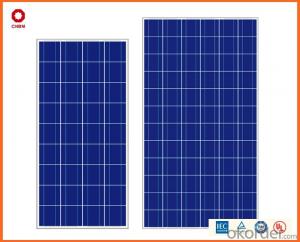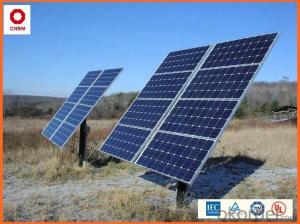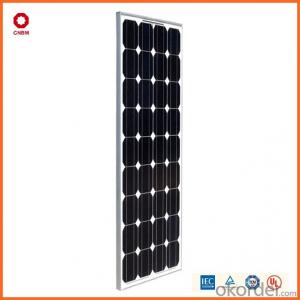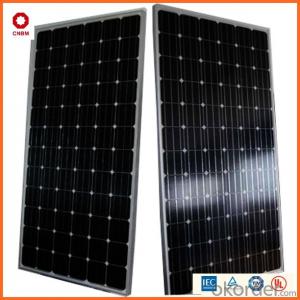70w Small Solar Panels in Stock - Solar Energy Systems Fort Pierce - China Manufacturer
- Loading Port:
- China main port
- Payment Terms:
- TT OR LC
- Min Order Qty:
- 1 watt
- Supply Capability:
- 10000000 watt/month
OKorder Service Pledge
OKorder Financial Service
You Might Also Like
Specification
Product Description:
Hot Sale !!! Quality and Safety of Small Poly Solar Panel 5w~150w
1. Rigorous quality control meets the highest international standards.
2. High-transmissivity low-iron tempered glass, strong aluminium frame.
3. Using UV-resistant silicon.
4. IS09001/14001/CE/TUV/UL
Warranties of Small Poly Solar Panel 35~85w
1. 10 years limited product warranty
2. 15 years at 90% of the minimal rated power output
3. 25 years at 80% of the minimal rated power output
Specification
Characteristics of Poly solar panels CNBM (245-320W) | |||||
Max Power Voltage Vmp(V) | 30.3 | 30.8 | 31.1 | 31.4 | 31.85 |
Max Power Current Imp(A) | 7.60 | 7.64 | 7.73 | 7.81 | 7.85 |
Open Circuit Voltage Voc(V) | 36.1 | 36.6 | 37 | 37.3 | 37.68 |
Short Circuit Current Isc(A) | 8.50 | 8.55 | 8.65 | 8.75 | 8.85 |
Max Power Pm(W) | 230W | 235W | 240W | 245W | 250W |
Temperature Coefficient of Cells Poly solar panels CNBM (245-320W) | |
NOCT | 45± 2 |
Temperature Coeffucients of Isc | 0.0492 |
Temperature Coeffucients of Voc | -0.3374 |
Temperature Coeffucients of Voc | -0.4677 |
Mechanical Data of Poly solar panels CNBM (245-320W) | |
Dimension | 1638 × 982 × 40 mm |
Weight | 19.5 kg |
No. of Cells and Connections | 60 (6 ×10) |
Tolerance | 0 ~ + 5 W |
Cell | Monocrystalline Cell 156 × 156 mm |
Packing | 624 Pcs/40ft(H) Container |
Limits of Poly solar panels CNBM (245-320W) | |
Operating Temperature | -40 to +85 |
Storage Temperature | -40 to +85 |
Max System Voltage | 1000VDC(IEC) / 600VDC(UL) |
Features of our products:
• High conversion efficiency mono/poly-crystalline amorphous silicon solar cells
• Modules incorporate high performance bypass diodes to minimize the power drop caused by shading
• High transmittance, low-iron tempered glass
• High performance EVA encapsulant to prevent destroying and water.
• AI frame: without screw, corner connection. 8 holes on the frame can be installed easily
• Good performance of preventing from atrocious weather such as wind and hails
• Certifications: CE IEC TUV VDE UL, Class I
• 10 years 90% power output warranty
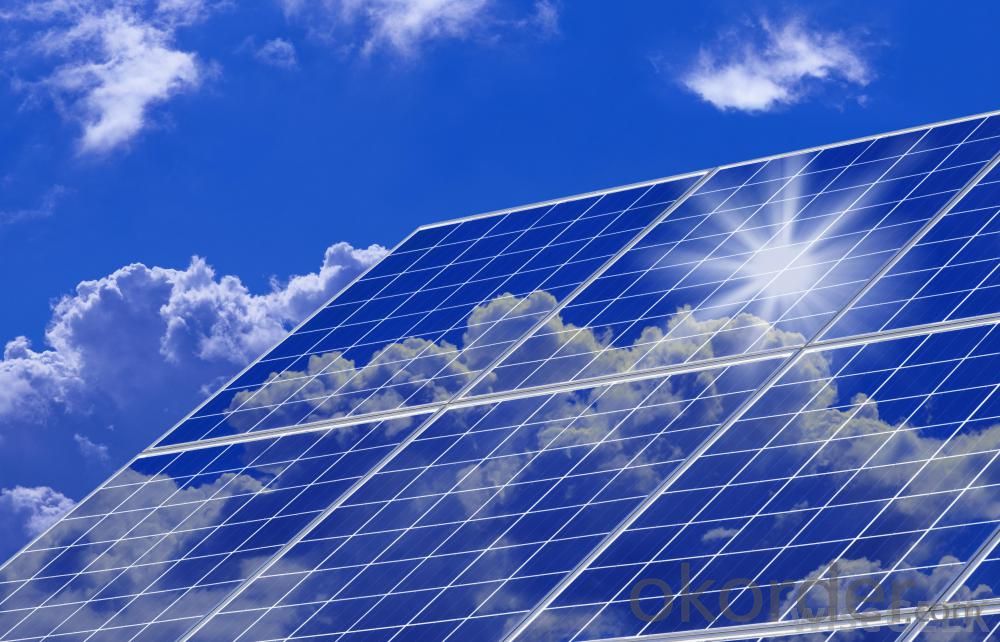
Shipping of Small Poly Solar Panel 35~85w
By Sea | Delivery from Shanghai or Ningbo seaport |
By Air | Departure from Shanghai Pudong Airport |
By Express | Post by DHL, EMS, UPS, TNT. |
Features of our products:
• High conversion efficiency mono/poly-crystalline amorphous silicon solar cells
• Modules incorporate high performance bypass diodes to minimize the power drop caused by shading
• High transmittance, low-iron tempered glass
• High performance EVA encapsulant to prevent destroying and water.
• AI frame: without screw, corner connection. 8 holes on the frame can be installed easily
• Good performance of preventing from atrocious weather such as wind and hails
• Certifications: CE IEC TUV VDE UL, Class I
• 10 years 90% power output warranty
As a professional Solar Panel manufacturer and Supplier in China, we have our customers come around the whole world and our specialization has got a worldwide recognition. Meanwhile, with our superior quality, competitive price, prompt and excellent service, As main role in trade section of CNBM Group, CNBM International Corporation supplies products including Monocrystalline Solar Panel, Polycrystalline Solar Panel ( multicrystalline silicon Solar Panel) have received and enjoyed famous reputation in many countries and regions in the world.
- Q: Are there any risks of electrical malfunctions or failures during extreme weather events with solar energy systems?
- Solar energy systems may encounter risks of electrical malfunctions or failures during extreme weather events. While solar panels are designed to withstand various weather conditions, such as rain, snow, and wind, they remain susceptible to damage in severe weather events like hurricanes, tornadoes, or severe storms. In extreme weather, high winds have the potential to physically harm solar panels by dislodging them from their mounts or causing them to break. Heavy snowfall can also cover the panels, reducing their efficiency and potentially causing them to collapse due to the weight. Additionally, lightning strikes during thunderstorms can jeopardize the electrical components of the solar energy system, leading to potential malfunctions or failures. Nevertheless, it is important to note that solar energy systems are typically equipped with safety measures to minimize these risks. Many solar panels undergo testing and certification to ensure they can withstand specific wind speeds and snow loads. Sturdy and secure mounting systems are utilized, and electrical components often have surge protection to safeguard against lightning strikes. Furthermore, solar energy systems are interconnected with the power grid, enabling a seamless transition to grid power during extreme weather events if needed. This helps mitigate the impact of potential malfunctions or failures. To mitigate the risks associated with extreme weather events, regular maintenance and inspection of solar energy systems are crucial. Periodic check-ups and cleaning can ensure the panels are in good condition, and any signs of damage or wear can be promptly addressed. It is also advisable to seek guidance from a professional installer or technician who can offer advice on specific weather-related risks and potential solutions.
- Q: How do solar energy systems affect roofing material warranties?
- Solar energy systems can potentially affect roofing material warranties by requiring penetrations in the roof for installation. These penetrations may void the warranty or require additional measures to maintain the warranty. It is important to consult with the roofing manufacturer and installer to understand the impact and ensure proper installation to avoid any warranty issues.
- Q: Can solar energy systems be used in powering construction sites or temporary structures?
- Yes, solar energy systems can definitely be used to power construction sites or temporary structures. In fact, solar power is increasingly being utilized in these scenarios due to its numerous advantages. Firstly, construction sites often lack access to traditional power sources, which makes solar energy a practical solution. Solar panels can be easily installed on rooftops, scaffolding, or even on the ground, providing a reliable source of electricity throughout the construction process. Secondly, solar energy systems offer flexibility in terms of power generation. They can be customized to meet specific energy demands of construction sites, whether it is for running power tools, lighting, or charging equipment. This adaptability ensures that construction activities can proceed smoothly without interruptions. Additionally, solar energy systems are environmentally friendly. By harnessing energy from the sun, construction sites can significantly reduce their carbon footprint and contribute to sustainable practices. Solar power does not produce harmful emissions or noise pollution, which is particularly beneficial in urban areas or sensitive environments. Furthermore, solar energy systems offer cost savings in the long run. While the initial investment for installing solar panels might be higher compared to traditional generators, the ongoing operational costs are significantly lower. Construction sites can benefit from reduced fuel expenses, maintenance costs, and reliance on fossil fuels. It is worth mentioning that solar energy systems can also be used for temporary structures such as mobile offices, portable restrooms, or event venues. These structures can be easily powered using solar panels, eliminating the need for generators or grid connections. In conclusion, solar energy systems are a viable and sustainable option for powering construction sites and temporary structures. They provide reliable, customizable, and cost-effective power solutions while minimizing environmental impact. As the global shift towards renewable energy continues, solar power will likely become even more prevalent in construction industry practices.
- Q: How long do solar energy systems typically last?
- Solar energy systems typically last for about 25 to 30 years.
- Q: Can solar panels be installed on different surfaces like glass or metal?
- Yes, solar panels can be installed on different surfaces like glass or metal. In fact, solar panels are commonly installed on glass surfaces, such as windows or skylights, to maximize sunlight exposure. Additionally, solar panels can also be mounted on metal roofs or other metal structures. The key requirement is ensuring a sturdy and secure installation to support the weight of the panels and maximize their efficiency.
- Q: How does the efficiency of solar panels vary across different installation locations?
- The efficiency of solar panels varies across different installation locations due to various factors such as the amount of sunlight received, the angle and orientation of the panels, shading, temperature, and local weather conditions.
- Q: Can solar energy systems be installed on mobile homes or RVs?
- Yes, solar energy systems can be installed on mobile homes or RVs. In fact, they are a popular choice for powering these vehicles as they provide a reliable and sustainable source of electricity while on the move. Solar panels can be mounted on the roof of the mobile home or RV, and the system can be customized to meet the specific energy needs of the vehicle.
- Q: What are the different mounting options for solar panels?
- The different mounting options for solar panels include roof-mounted, ground-mounted, pole-mounted, and tracking systems. Roof-mounted systems are the most common and are installed on the roof of a building. Ground-mounted systems are installed on the ground using a fixed structure or a tracking system. Pole-mounted systems are mounted on poles and can be adjusted for optimal sun exposure. Tracking systems allow solar panels to move and follow the sun's path throughout the day, maximizing energy production.
- Q: Can solar energy systems be used for heating and cooling a home?
- Yes, solar energy systems can be used for heating and cooling a home. Solar heating systems, such as solar thermal collectors or solar water heaters, can be used to heat water or air for space heating purposes. Additionally, solar air conditioning systems, such as solar-powered absorption or desiccant cooling systems, can be used to cool a home using the energy from the sun.
- Q: Can solar energy systems be easily expanded or upgraded?
- Yes, solar energy systems can be easily expanded or upgraded. One of the major advantages of solar technology is its modular nature, allowing for scalability and flexibility. If you have additional space available, you can simply add more solar panels to increase the capacity of your system. Additionally, advancements in solar technology have made it easier to integrate new panels with existing systems. Upgrading a solar energy system can also be done by replacing older or less efficient components with newer and more efficient ones, such as upgrading to higher capacity inverters or adding battery storage for energy storage purposes. The expandability and upgradability of solar energy systems make them a cost-effective and sustainable choice for meeting increasing energy demands over time.
Send your message to us
70w Small Solar Panels in Stock - Solar Energy Systems Fort Pierce - China Manufacturer
- Loading Port:
- China main port
- Payment Terms:
- TT OR LC
- Min Order Qty:
- 1 watt
- Supply Capability:
- 10000000 watt/month
OKorder Service Pledge
OKorder Financial Service
Similar products
Hot products
Hot Searches
Related keywords
